Small-spotted Catshark
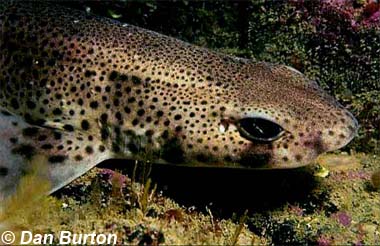
Scyliorhinus canicula
This small, nocturnal catshark is a light sandy color with slightly darker saddles and patches, and a lot of dark spots all over it. Slim and long, with a blunt snout and large cat-like eyes, it has small lobed fins set back closer to its asymmetrical caudal fin. It is abundant in the coastal waters around Europe and Northern Africa, where it eats mollusks and crustaceans, and grows to around 39 inches long.
Order – Carcharhiniformes
Family – Scyliorhinidae
Genus – Scyliorhinus
Species – canicula
Common Names
English language common names are small-spotted catshark, dogfish, fay dog, lesser spotted catshark, lesser spotted dogfish, rough dog, rough hound, sandy dogfish, small spotted dog, and small-spotted cat shark. Other common names include an fíogach beag (Irish), attaredda (Italian), breka (Spanish), cacciottiello (Italian), cacciuni (Italian), cacciuottolo (Italian), cagnotiello (Italian), cagnulu (Italian), canicchie (Italian), cat (Spanish), catarouquiera (French), catarousse (French), cattuzzu (Italian), catuarraya (Spanish), cazzuni (Italian), charotel (French), chat de mer (French), chat marin (French), deplaháfur (Icelandic), galeo (Spanish), gat (French), gata (Italian), gata de quarnero (Italian), gatanghier (French), gatet (Spanish), gato marino (Spanish), gattaccio minore (Italian), gattaiellu (Italian), gattareddu (Italian), gattarell (Maltese), gattarell tat-tikek (Italian), gattina (Italian), gattocele (Italian), gattod (Italian), gattodde (Italian), gattu di mari (Italian), gattuccia (Italian), gattuccio (Italian), gattucciu (Italian), gattuso (Italian), gatuso (Italian), gatuzza (Italian), gatvaire (Spanish), gatón patarroxa (Spanish), gildan (Hebrew), gildon kalbi (Hebrew), gobbag hooill (Manx), gátos (Greek), hondshaai (Dutch), irsh (Arabic), jadduzzu (Italian), jattupaddu (Italian), jattupardu (Italian), kalb el bah’r (Arabic), katzenhai (German), kedi baligi (Turkish), kedib (Turkish), kelb el bahr (Arabic), kleiner katzenhai (German), kleingefleckter katzenhai (German), koshacha akula (Ukrainian), koshachya akula (Russian), liabarda (Italian), mace-deti (Albanian), macka bjelica (Serbian), macka bljedica (Croatian), mamatxa (Spanish), melgacho (Spanish), mice-deti (Albanian), mona (Spanish), morska macka (Serbian), obyknovennaya koshach’ya akula (Russian), parda (Croatian), pardolle (Italian), pata-roxa (Portuguese), pesce cagnolo (Italian), petite rousette (French), petite roussette (French), pez perro (Spanish), pintarroja (Spanish), pinto-rousso (Italian), pistepunahai (Finnish), pitarrosa (Spain), pitarrosa de altura (Spanish), pitarrosin (Spanish), rekinek psi (Polish), rijanka (Croatian), rosetta minore (Italian), rousse (French), roussette (French), rødhai (Norwegian), salamine (Italian), skylopsaraki (Greek), skylopsaro (Greek), skylàki (Greek), småflekket rødhai (Norwegian), småfläckig rödhaj (Swedish), småplettet rødhaj (Danish), and squale roussette (French).
Importance to Humans
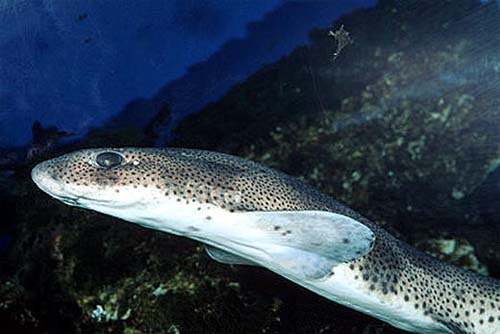
The small-spotted catshark is of only moderate commercial fisheries importance, however it is utilized in public aquarium display tanks. Along the British Isles, this catshark is primarily taken by bottom trawls, however it is also caught with fixed bottom nets and even pelagic trawls. When landed by fishers, this species is utilized fresh and dried-salted for human consumption. It is also utilized for fish meal and oil.
SCUBA divers are able to approach the small-spotted catshark but depending on the situation, the shark may bolt when approached closer than about a meter. Scientists also use this common species as a “lab rat” in the study of various systems within the body including hormones, blood, and organs.
Danger to Humans
The small-spotted catshark is considered harmless to humans due to its small size, habitat preference, and feeding habits.
Conservation
Due to its abundance, this catshark has not been assessed or evaluated by the World Conservation Union (IUCN). The IUCN is a global union of states, governmental agencies, and non-governmental organizations in a partnership that assesses the conservation status of species.
> Check the status of the small-spotted catshark at the IUCN website.
Geographical Distribution
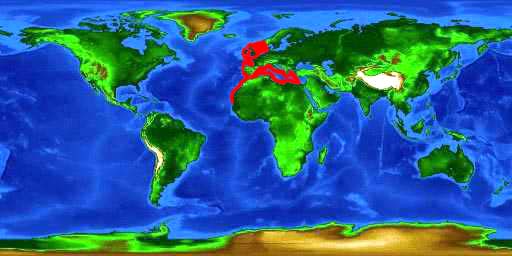
This small catshark is limited in distribution to the northeast Atlantic Ocean from Norway and British Isles south to Senegal, including the Mediterranean. It is common and widespread all along the coasts of Britain and Ireland. There is also a possibility that it also resides off the Côte d’Ivoire. Some populational differences exist between Catulus duhameli(a name for the Mediterranean canicula based on its smaller size) and this species which may eventually be expressed as subspecies.
Habitat
Residing along continental shelves and the uppermost slopes, the small-spotted catshark is found over sandy, coralline, algal, gravel and muddy bottoms at depths ranging from 33-1,312 feet (10-400 meters). It is more commonly observed at depths to 361 feet (110 meters). Juveniles are found in shallow water and often segregate by sex. This species is nocturnal, remaining motionless during the daytime hours and actively searching for prey at night.
Biology
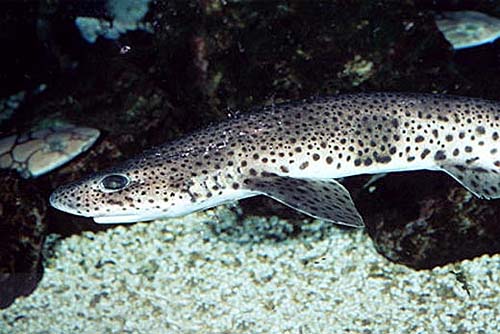
Distinctive Features
The small-spotted catshark is a small, slender shark with a blunt head, elongated eyes, and a rounded snout. The expanded anterior nasal flaps reach the mouth and cover the shallow nasoral grooves. Labial furrows are present on the lower jaw only. There are five pairs of gill slits with the last two overlapping the pectoral fins. There are two spineless dorsal fins with the first dorsal fin larger than the second dorsal fin. The first dorsal fin origin is positioned posterior to the pelvic fin insertions while the second dorsal fin origin is over the insertion of the anal fin. The anal fin base is elongate and measures less than the interdorsal (between the dorsal fins) space.
A similar species, the greater spotted catshark (Scyliorhinus stellaris), can be distinguished from the small-spotted catshark by its larger leopard-like spots. It can also be distinguished by their nasal grooves which are connected to the mouth in the small-spotted catshark but are unconnected in the greater spotted catshark.
Coloration
The dorsal surface is grayish-brown and patterned with many small dark and sometimes lighter spots. The small-spotted catshark also has 8-10 dark patches forming dusky saddles along the dorsum, however these saddles may be obscure. The ventral surface is a lighter gray to white in color.
Dentition
The teeth are numerous and very small with one large cusp with small cusplets on either side near the center portion of the mouth while the rear teeth are more comb-like in shape.
Denticles
The denticles of this catshark are small resulting in a skin that does not feel extremely rough when touched.
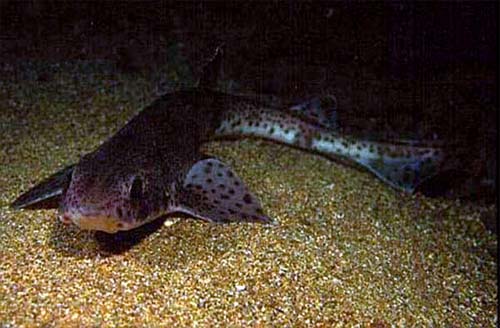
Size, Age, and Growth
The maximum reported size of the small-spotted catshark is 39 inches (100 cm) total length and the maximum reported weight of this species is just under 3 pounds (1,320 g). along the British Isles and the North Sea. In the Mediterranean region, this species is smaller. It lives to a maximum age of at least 12 years. Sexual maturity is attained at total lengths of 21-24 inches (54.0-60.0 cm) for both males and females, correlating to an age of 3 to almost 8 years.
Food Habits
This small shark feeds on marine invertebrates including mollusks, crustaceans, cephalopods, and polychaete worms. It also feeds on small bony fish such as gobies, pilchards, juvenile mullet, damselfish and dabs, and occasionally larger fish such as gurnards or whiting.
Reproduction
Mating occurs in deeper waters from the late summer through autumn, when females move back to shallower spawning grounds and deposit their eggs until the peak months of June and July. As an oviparous species, the small-spotted catshark lays a single egg per oviduct at a time with embryos relying solely on the yolk for nutrition. The large egg cases are laid in pairs and snag via tendrils on suitable substrate such as macroalgae in shallow water. Up to 18-20 egg cases may be released during each reproductive season. In captivity, the eggs took 5-6 months to hatch with neonates measuring approximately 3.5-3.9 inches (9-10 cm) in length.
Predators
Larger fish including sharks are potential predators of the small-spotted catshark.
Parasites
Parasites of the small-spotted catshark include the copepod Lernaeopoda galei, monogeneans Leptocotyle minor and Hexabothrium appendiculatum, and larval anisakid nematodes.
Taxonomy
The small-spotted catshark was originally described as Squalus canicula by Linnaeus. This name was later changed to the currently valid scientific name of Scyliorhinus canicula (Linnaeus 1758). The genus name Scyliorhinus comes from the Greek “skylla” meaning a kind of shark and “rhinos” meaning nose. This catshark is a member of the Scyliorhinidae family. Synonyms referring to this species in previous scientific literature include Squalus catulus Linnaeus 1758, Squalus elegans Blainville 1825, Scyllium spinacipellitum Valliant 1888, Scyllium acutidens Valliant 1888, Scyliorhinus canicula albomaculata Pietschmann 1906, and Catulus duhamelii Garmin 1913.
Prepared by: Cathleen Bester